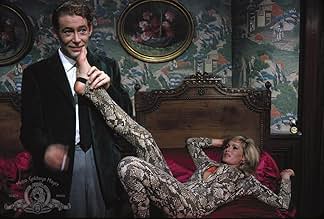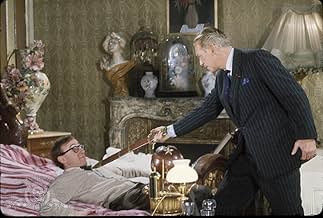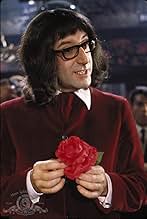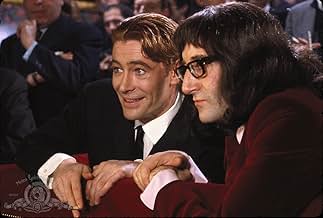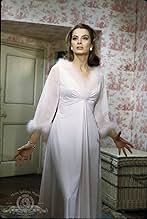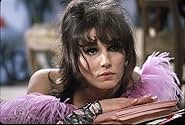Ein Playboy, der sich weigert, seine hedonistische Lebensweise aufzugeben, um eine Familie zu gründen und seine wahre Liebe zu heiraten, bittet einen verrückten Psychoanalytiker um Hilfe, de... Alles lesenEin Playboy, der sich weigert, seine hedonistische Lebensweise aufzugeben, um eine Familie zu gründen und seine wahre Liebe zu heiraten, bittet einen verrückten Psychoanalytiker um Hilfe, der selbst romantische Probleme hat.Ein Playboy, der sich weigert, seine hedonistische Lebensweise aufzugeben, um eine Familie zu gründen und seine wahre Liebe zu heiraten, bittet einen verrückten Psychoanalytiker um Hilfe, der selbst romantische Probleme hat.
- Für 1 Oscar nominiert
- 4 Nominierungen insgesamt
- Michael James
- (as Peter O'toole)
- Anna Fassbender
- (as Edra Gale)
- Mrs. Werner
- (as Eleonor Hirt)
- Marcel
- (as Jean Paredes)
Empfohlene Bewertungen
There is a bevy of beautiful women here. Paula Prentiss gets the most obviously outrageous role: a suicidal poetry-with-a-social-conscience writer who's also a performer at the Crazy Horse Saloon. The exquisite Capucine shows off her remarkable flair for physical comedy. Ursula Andress doesn't have to do anything other than show up in a bikini, but even she turns out to be a delightful comedienne. Romy Schneider doesn't fare as well. She looks amazing, but her character is cloying. She does shine, however, in the hilarious English-as- a-second-language class sequence.
There are some other gems: The nighttime courting below the window, the group therapy sessions, the library bully. The film comes to life at the end when it turns into pure slapstick. It contrives to assemble all the characters in a French château, with everyone chasing after each other in some cleverly devised sight gags. Just don't look for consistency, coherence, or continuity in this film. They don't exist. Enjoy it, instead, as a series of comic set-pieces.
There are some excellent bits - Romy Schneider, as Michael's fiancée and number one girlfriend, Carole, runs a language class which pitches in on a quarrel she has with him ('Goodbye, Goodbye, Goodbye' - 'You're all parrots!); Michael has nightmares where Sellers appears as, yup, Richard III, and all his girlfriends converge on him like a swarm of ants; Sellers plans a Viking funeral suicide (swathed in the Union Jack) but is interrupted by Allen dining al fresco for his birthday; O'Toole assists Sellers in a Cyrano de Bergerac style wooing; and there is frentic chase involving go-karts towards the end of the film. All this and the opera-shrilling psychiatrist's wife. And a lot of potted plants.
Fun food for the eyes really and a no-brainer, but 'What's New Pussycat?' is fun, off-the-wall, and requires no real attention span. O'Toole was certainly right for the part and of course, there is always Tom Jones' famous theme song and the cartoon credits with a chorus line of pussycats ...
The story turns out to be centered on a handsome man, Michael James (Peter O'Toole), who attracts women even more than he's attracted to them. He calls them all "pussycat", and that's about all he needs to do to have them ready to jump into bed with him. He's most in love with Carole Werner (Romy Schneider), who keeps pressuring him to get married, but he isn't ready to ditch his polyamorous ways, and he doesn't want to cheat on her after they're married. Michael's psychoanalyst, Dr. Fritz Fassbender (Peter Sellers), is also something of a womanizer, but women don't seem to like him near as much. Michael is also an acquaintance of Victor Shakapopulis (Woody Allen), who is moderately successful with women, but most importantly, he is also in love with Carole. The plot involves various sticky situations, so to speak, between these characters and various ancillary characters.
In addition to appearing as a co-star, Woody Allen wrote the script. This was his first real film. He had done a short called The Laughmaker in 1962, and a lot of television prior to What's New, Pussycat? and of course he had done a lot of stand-up. The script is good, at least on the "trees" level (as opposed to the "forest" level), and Allen's performance in his first film makes it easy to see how he became such a big star. He steals the film whenever he appears. O'Toole, who I've never been a very big fan of, tends to come across with an odd combination of stiffness and pretentiousness, despite Allen's good writing. Sellers seems as if director Clive Donner kept him in check a bit too much, and subsequently can seem lost. But Allen's now famous stock film personality shines through in his scenes. Performing his own comedy, even though he didn't direct, Allen's scenes flow, seem natural, have perfect timing, and are very funny.
Still, it might be difficult to not blame Allen for some of the overall messiness of the story--on the "forest" level. Donner starts with a scene that may be attractive visually--it features Sellers and his Wagnerian Viking wife bickering in their unusual home, shot from a wide angle so we can see the entire front of the house while they run around to from room to room, stairway to stairway--but the unusualness doesn't seem to have much point dramatically. That's indicative of problems to come. Donner too frequently blocks and shoots scenes at unfortunate angles. And there are far too many scenes that seem to be there just to be groovy or unusual, but they drag down the plot, sometimes almost grinding it to a halt.
As the film progresses, the complex relationships involving many different parties can become confusing. It doesn't help that some actors change their look--such as cutting their hair--as the film unfolds. Ancillary characters can come and go without warning and with little explanation. The climax depends on a large number of people heading to the same location, but for half of them, it's not at all clear why they head there, they just announce that they're going. The climax is still a bit funny, and it's one of the better and more complexly staged sequences, but it doesn't have anything like the impact it should. Story-wise, the film feels over before the climax even arrives.
As I just mentioned in my (more favorable) review of the same year's Dr. Goldfoot and the Bikini Machine, the 1960s, because of a number of factors including the near non-existent application of the dreaded Hays Production Code at this point and a general social atmosphere of experimentation, resulted in films that tended to be sprawling and experimental in their approach to such basics as plot. What's New, Pussycat? is a prime example. It often becomes clear that plot is being played with in a way that leads to occasional abandonment. In a way, What's New, Pussycat? is more just a collection of skits or scenarios, with a loosely related theme. While I'm a fan of experimentation and I admire the loosey-goosey, stream-of-consciousness attitude suggested, and Allen certainly satisfies my taste for absurdism in some of his scenarios (such as his birthday dinner), the fact remains that in this case, the plot experimentation just doesn't quite work.
The final judgment, however, is that I slightly recommend What's New, Pussycat? but primarily to see Allen's scenes and enjoy the writing of his scenarios. There are other attractors and interesting aspects, including the fact that Ursula Andress has probably never looked better than she does here (although she's looked as good), but like an unfortunate many of these 1960s "madcap comedies", What's New, Pussycat? should be approached with a bit of caution.
'What's New, Pussycat?' is not a great movie. There isn't much in the way of a plot, it's constructed haphazardly, and parts of it don't make a lot of sense.
That's part of its charm. 'The Pink Panther', from the same era, also has a large, recognizable, hugely talented cast, and it's a much more coherent, technically proficient film. It is also less funny.
Just in case you've never seen anything about the movie before: Peter O'Toole plays Michael, a magazine writer and philanderer in mid-1960's Paris. His dilemma (dramatic conflict, if you will) is Carol (Romy Schneider) a woman he loves so much he wants to be faithful to her, if indeed he can give up all other women and marry her. Other women include Paula Prentiss, Capucine, and Ursula Andress; Woody Allen is the friend with the not so secret crush on Carol. Michael's psychoanalyst is played by Peter Sellers, which should tell you about as much as you need to know.
WNP? has a mood, created in large part by the Bacharach score, that I don't want to call innocent because it tries so hard to be naughty, but there it is. The drug culture hadn't yet picked up the cultural grip released by post-50's paranoia, and a sloppy, silly picture like this seemed to be a good idea.
And that's enough of that; a movie that contains the line 'it's my wife the creature that ate Europe' shouldn't be over-analyzed. Enjoy it for what it is.
Wusstest du schon
- WissenswertesRichard Burton: Uncredited, as man in a strip club. Burton appears with Peter O'Toole in a scene in a bar where Burton asks O'Toole, "Haven't you met me somewhere before?" O'Toole responds: "Yes - I can remember the name, but I can't quite place the face", adding, as he turns away, "Give my regards to what's-her-name". The dialogue is a reference to their appearance together in Becket (1964), and to Burton's wife at the time, Elizabeth Taylor.
- PatzerWhen the anarchist's bomb explodes, Carole does not react to it, although everybody else does.
- Zitate
Michael James: Did you find a job?
Victor Skakapopulis: Yeah, I got something at the striptease. I help the girls dress and undress.
Michael James: Nice job.
Victor Skakapopulis: Twenty francs a week.
Michael James: Not very much.
Victor Skakapopulis: It's all I can afford.
- Crazy CreditsThe opening/closing titles feature a host of Cupid cherubs in cat masks performing various gags.
- VerbindungenFeatured in Die Unverbesserlichen: Nichts dazugelernt (1966)
Top-Auswahl
- How long is What's New Pussycat?Powered by Alexa
Details
- Erscheinungsdatum
- Herkunftsländer
- Sprachen
- Auch bekannt als
- What's New Pussycat
- Drehorte
- Produktionsfirmen
- Weitere beteiligte Unternehmen bei IMDbPro anzeigen
Box Office
- Bruttoertrag in den USA und Kanada
- 18.820.000 $
- Laufzeit
- 1 Std. 48 Min.(108 min)
- Farbe
- Seitenverhältnis
- 1.66 : 1


